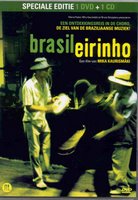
Luiz Americano (1900-1960) is regarded one of the Brazilian masters of clarinet choro. Alvaro Neder writes about Americano in a career profile in AMG:



 A year ago I was introduced to Choro music by my friend Jørgen Larsen, co-editor of his blog. In Copenhagen (Denmark) we joined the group Choro Brasil Scandinavia in a concert and a jam session with Jacob Fischer, a Danish jazz guitarist and his trio.
A year ago I was introduced to Choro music by my friend Jørgen Larsen, co-editor of his blog. In Copenhagen (Denmark) we joined the group Choro Brasil Scandinavia in a concert and a jam session with Jacob Fischer, a Danish jazz guitarist and his trio. My copy ( the Dutch version - spoken in Portuguese with Dutch and French subtitles) of
Brasileirinho isn't a choro history or something like that - it introduces and follows a group of choro players, who talk about there common passion of choro and how this kind of music is integrated in their daily life. There is a lot of music in it - and one could compare it with the well known Buena Vista Social Club documentary in which Wim Wenders follows a group of Cuban musicians. The musicians tell about their instruments, about how they got involved in choro music, We follow them at rehearsals or discussions about harmonic structures and for me it was striking to learn how much choro and jazz have in common.
The documentary ends with a concert, on choro day, 23 april (the birthday of Pixinguinha), in which all musicians, from young to old, play their music.
Of course Jørgen will present us an extensive review later,as soon as he has his copy - I'm sure. He's the expert of the two of us.
In the mean time I'd suggest - get yourself a copy of this great portrait of Choro music.
